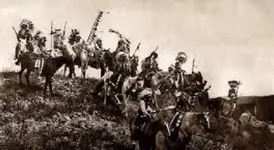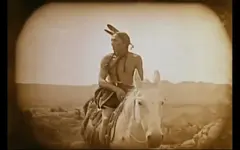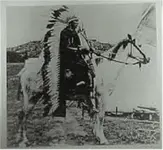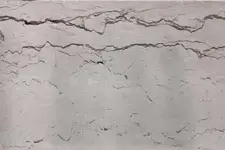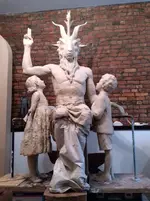Initial Contact with the Mayo Indians (1609-1610). The Mayo Indians were an important Cáhita-speaking tribe occupying some fifteen towns along the Mayo and Fuerte rivers of southern Sonora and northern Sinaloa. As early as 1601, they had developed a curious interest in the Jesuit-run missions of their neighbors. The Mayos sent delegations to inspect the Catholic churches and, as Professor Spicer observes, "were so favorably impressed that large groups of Mayos numbering a hundred or more also made visits and became acquainted with Jesuit activities." As the Jesuits began their spiritual conquest of the Mayos, Captain Hurdaide, in 1609, signed a peace treaty with the military leaders of the Mayos.
Spanish Contact with the Yaqui Indians (1610). At contact, the Yaqui Indians occupied the coastal region of Sinaloa along the Yaqui River. Divided into eighty autonomous communities, their primary activity was agriculture. Although the Yaqui Indians had resisted Guzmán's advance in 1531, they had welcomed Francisco de Ibarra who came in peace in 1565, apparently in the hopes of winning the Spaniards as allies in the war against their traditional enemies, the Mayos.
In 1609, as Captain Hurdaide became engaged with the pacification of the Ocoronis (another Cahita-speaking group of northern Sinaloa), he reached the Yaqui River, where he was confronted by a group of Yaquis. Then, in 1610, with the Mayo and Lower Pima Indians as his allies, Captain Hurdaide returned to Yaqui territory with a force of 2,000 Indians and forty Spanish soldiers. He was soundly defeated. When he returned with another force of 4,000 Indian foot soldiers and fifty mounted Spanish cavalry, he was again defeated in a bloody daylong battle.
Conversion of the Mayo Indians (1613-1620). In 1613, at their own request, the Mayos accepted Jesuit missionaries. Soon after, the Jesuit Father Pedro Mendez established the first mission in Mayo territory. In the first fifteen days, more than 3,000 persons received baptism. By 1620, with 30,000 persons baptized, the Mayos had been concentrated in seven mission towns.
Conversion of the Yaqui Indians (1617-1620). In 1617, the Yaquis, utilizing the services of Mayo intermediaries, invited the Jesuit missionaries to begin their work among them. Professor Spicer noted that after observing the Mayo-Jesuit interactions that started in 1613, the Yaquis seemed to be impressed with the Jesuits. Bringing a message of everlasting life, the Jesuits impressed the Yaquis with their good intentions and their spirituality. Their concern for the well being of the Indians won the confidence of the Yaqui people. In seeking to protect the Yaqui from exploitation by mine owners and encomenderos, the Jesuits came into direct conflict with the Spanish political authorities. From 1617 to 1619, nearly 30,000 Yaquis were baptized. By 1623, the Jesuits had reorganized the Yaquis from about eighty rancherías into eight mission villages.
Detachment of the Province of Sinaloa and Sonora (1733). In 1733, Sinaloa and Sonora were detached from Nueva Vizcaya and given recognition as the province of Sonora y Sinaloa. This detachment represented a recognition of "the growth of a mining and ranching secular society in this northwestern region."
Rebellion of the Yaqui, Pima, and Mayo Indians - Sinaloa and Sonora (1740). The Yaqui and Mayo Indians had lived in peaceful coexistence with the Spaniards since the early part of the Seventeenth Century. The cause of this rebellion was that the Jesuits had ignored " the growing Yaqui resentment over lack of control of productive resources." During the last half of the Seventeenth Century, so much agricultural surplus was produced that storehouses needed to be built. These surpluses were used by the missionaries to extend their activities northward into the California and Pima missions. The immediate cause of the rebellion is believed to have been a poor harvest in late 1739, followed in 1740 by severe flooding which exacerbated food shortages.
The increasingly bureaucratic and inflexible Jesuit organization obdurately disregarded Yaqui demands for autonomy in the selection of their own village officials. Thus, this rebellion was a more limited endeavor to restore the colonial pact of village autonomy and territorial integrity. At the beginning of the revolt, an articulate leader named El Muni emerged in the Yaqui community. El Muni and another Yaqui leader, Bernabé, took the Yaquis' grievances to local civil authorities. Resenting this undermining of their authority, the Jesuits had Muni and Bernabé arrested.
The arrests triggered a spontaneous outcry, with two thousand armed indigenous men gathering to demand the release of the two leaders. The Governor, having heard the complaints of both sides, recommended that the Yaqui leaders go to Mexico City to testify personally before the Viceroy and Archbishop Vizrón.
In February 1740, the Archbishop approved all of the Yaqui demands for
free elections,
respect for land boundaries, that Yaquis
be paid for work, and
that they not be forced to work in mines.
The initial stages of the 1740 revolt saw sporadic and uncoordinated activity in Sinaloa and Sonora, primarily taking place in the Mayo territory and in the Lower Pima Country. Catholic churches were burned to the ground while priests and settlers were driven out, fleeing to the silver mining town at Alamos. Eventually, Juan Calixto raised an army of 6,000 men, composed of Pima, Yaqui and Mayo Indians. With this large force, Calixto gained control of all the towns along the Mayo and Yaqui Rivers.
However, in August 1740, Captain Agustín de Vildósola defeated the insurgents. The rebellion, however, had cost the lives of a thousand Spaniards and more than 5,000 Indians. After the 1740 rebellion, the new Governor of Sonora and Sinaloa began a program of secularization by posting garrisons in the Yaqui Valley and encouraging Spanish residents to return to the area of rebellion. The Viceroy ordered the partition of Yaqui land in a "prudent manner." The Yaquis had obtained a reputation for being courageous warriors during the rebellion of 1740 and the Spanish handled them quite gingerly during the late 1700s. As a result, the
government acquisition of Yaqui lands did not begin began until 1768.
Pima Rebellion of 1751-1752. The Pima Indians have lived for many centuries in scattered locations throughout what are today the western two-thirds of southern Arizona and northern Sonora. While the Pimas Altos (Upper Pima Indians) lived in the north, their linguistic brethren, the Pima Bajo (Lower Pima) lived farther south in lower Sonora.
During the 1740s, the Pima Indians began to feel agitated by the presence of the Spaniards in their territory. In November 1751, under the leadership of a Pima leader, Captain-General Luís Oacpicagigua, the Pima rose in revolt. Within a few days more than a hundred settlers, miners, and ranchers were killed. Churches were burned, and two priests were also killed. However, on January 4, 1752, approximately 2,000 northern Pimans attacked less than one hundred Spaniards, only to be repulsed with a loss of forty-three dead. The Pima Revolt lasted only four months, ending with the surrender of Luís Oacpicagigua, who offered himself in sacrifice and atonement for his whole people, endeavoring to spare them the consequences of their uprising.
Apache Offensives in Sonora and Chihuahua (1751-1774). The word "Apache" comes from the Yuma word for "fighting-men". It also comes from a Zuni word meaning "enemy". Cynthia Radding, the author of The Colonial Pact and Changing Ethnic Frontiers in Highland Sonora, 1740-1840, refers to the Apaches as "diverse bands" of hunter-gatherers "related linguistically to the Athapaskan speakers of Alaska and western Canada." The Apaches were composed of six regional groups: (1) the Western Apaches (Coyotero) of eastern Arizona; (2) the Chiricahua of southwestern New Mexico, southeastern Arizona, Chihuahua and Sonora; (3) the Mescalero of southern New Mexico; (4) the Jicarilla of Colorado, northern New Mexico and northwestern Texas; (5) the Lipan Apache of New Mexico and Texas; and (6) the Kiowa Apache of Colorado, Oklahoma, and Texas.
The first Apache raids on Sonora appear to have taken place during the early part of the late Seventeenth Century. In fact, to counter the early Apache thrusts into Sonora, presidios were established at Janos (1685) in Chihuahua and at Fronteras (1690) in northern Opata country. The Apache depredations continued into the Eighteenth Century and prompted Captain Juan Mateo Mange in 1737 to report that
"many mines have been destroyed, 15 large estancias along the frontier have been totally destroyed, having lost two hundred head of cattle, mules, and horses; several missions have been burned and two hundred Christians have lost their lives to the Apache enemy, who sustains himself only with the bow and arrow, killing and stealing livestock. All this has left us in ruins."
In the 1750s, the fiercest of all Apache tribes, the Chiricahua, began hunting and raiding along the mountainous frontier regions of both Sonora and Chihuahua. In 1751, the Sonorans mounted a punitive campaign against the Chiricahua, capturing two of their leaders. In 1753 and 1754, the Apaches once again attacked the settlements and ranches near Valle de San Buenaventura and Casas Grandes. As a result, another expedition of 190 Sonorans, 140 Opata allies, and 86 Spanish troops from Chihuahua went out in search of the marauders during 1756. When Apache raiders hit the region south of San Buenaventura in late 1760, an expedition of 100 Spanish troops and 130 Indian auxiliaries attacked the raiders.
The pressure of constant warfare waged against these nomads led the Spanish military to adopt a policy of maintaining armed garrisons of paid soldiers (presidios) in the problem areas. By 1760, Spain boasted a total of twenty-three presidios in the frontier regions. But the Apaches, responding to these garrisons, developed "important adaptations in their mode of subsistence, warfare, and social organization. They became highly skilled horsemen whose mobility helped them elude presidio troops.
Professor Robert Salmon, the author of Indian Revolts in Northern New Spain: A Synthesis of Resistance (1680-1786) writes that the continuing Indian attacks eventually "broke the chain of ineffective presidios established to control them." As the end of the Eighteenth Century approached, the Apaches represented a major threat to the continued Spanish occupation of Sonora and Chihuahua. And, as Professor Salmon concludes, "Indian warriors exacted high tolls in commerce, livestock, and lives." The damage caused by Apache raids was calculated in hundreds of thousands of pesos, and many ranches, farms and mining centers throughout Chihuahua had to be abandoned.
Professor Griffen mentions that the Apache raiders in Chihuahua "displaced or assimilated other groups of hunter-gatherers known as the Sumas, Mansos, Chinarras, Sumanos, Jocomes, and Janos." As a result, Ms. Radding observes, the Spaniards, Pimas, and Opatas found it necessary to form "an uneasy, but necessary, alliance against the Apaches." The Opata Indians controlled the major river valleys of Central Sonora.
Seri Offensives (1757-1766). At the time of contact, the Seri Indians lived along the arid central coast of Sonora and shared boundaries with the Yaqui on the south and the Pima and Pápago on the east and north. The first known battle between the Seris and the Spaniards took place in 1662. A century later, on November 3, 1757, a war party of Seris and rebel northern Pimans struck the settlement of San Lorenzo (Sonora), killing thirty-two persons. This brazen affront called for military reprisal, and the Spaniards collected troops to chase the offenders back to the coastal area.
In 1760, Captain Juan Bautista de Anza took over command of the Tubac Presidio in Southern Arizona and embarked into Seri country near the Gulf of California. In 1761, presidios were denuded of troops in order to supply personnel and materials for the offensive. A force of 184 Spanish soldiers, 217 allied Indians and twenty citizens went on the offensive against the Seris. They succeeded in slaying forty-nine Seris and capturing sixty-three, while recovering 322 horses.
In 1767 King Carlos III abruptly banished the Jesuits from all his realms. Hundreds of mission establishments, schools and colleges had to be turned over to other missionary orders or converted to other uses. The Franciscans who took over the missionary effort in Sonora and Chihuahua inherited all the woes that had frustrated the Jesuits: restless neophytes, Apache hostility, disease, encroaching settlers, and lack of government support.
The Sonora Campaign (1767-1771). The Sonora Expedition of 1767 was led by Colonel Domingo Elizondo. The expedition was the result of demands by settlers in Sonora who had for decades suffered raids by warring ranchería groups of that province. Pacification of rebel Indian warriors of the coastal region was the main objective of the expedition that was comprised of an extraordinary 1,100 men. This expedition represented the greatest military effort yet seen in this Spanish frontier province.
During 1768, Colonel Elizondo's forces split up in an attempt to drive the Seri Indians into one area where a decisive battle could be fought. This mission failed to achieve its objective. The Indians, now well-trained in the art of hit-and-run and ambush style warfare, avoided direct confrontations with large Spanish armies. In 1771, after thirty-eight months of fighting, the Central Government in Mexico City put a stop to the Sonora Campaign, which was regarded as both costly and unsuccessful.
Peace Negotiations with the Apaches and Comanches (1777 - 1796). In 1777-78, Teodoro de Croix, the Commandant General of the Interior (frontier) provinces of Nueva España, called together three great conferences to discuss the Apache problem. The Apache problem had existed on the frontier since the Spanish entered the country, and each year it grew worse. The Apaches had five thousand warriors, armed with bows, lances, and firearms. They attacked only by surprise and only when they had the advantage.
Croix determined that it would take an army of at least 3,000 soldiers to confront and eliminate the Apache threat. He thus came to the conclusion that an alliance with the Comanches - the dreaded enemies of the Apaches - would bring about a resolution of the Apache problem. However, bogged down with "bureaucratic delays and obfuscation," de Croix was never able to get the money or men to implement this plan.
In 1779, Juan Bautista de Anza, the commander of the Tubac Presidio, gathered together an army of 600 men, which included 259 Amerindian auxiliaries and Spanish civilians, and marched north to the Colorado Plateau, in search of Comanches. Having estimated the Comanche population at 30,000 warriors spread across a large area, Anza attacked and surprised several bands of Comanches during 1783-84. Anza, operating with native allies and utilizing Indian tactics, earned the respect of the Comanches.
In 1785, the Comanches started negotiations with Anza. The following year, a peace treaty was signed in which several of the Comanche tribes pledged to assist the Spaniards against the Apaches. Through this agreement, The Comanches could now ride openly into Spanish settlements and New Mexican traders could move safely on the Comanche plains.
In 1786, the Viceroy of Nueva España, Bernardo de Galvez, instituted a series of reforms for the pacification of the frontier. His Instruccion of that year called for the formation of peace establishments (establecimientos de paz) for Apaches willing to settle down and become peaceful. Oscar J. Martínez, the author of Troublesome Border, described Spain's new policy of "pacification by dependency" toward the indigenous peoples. "Henceforth," writes Mr. Martínez, "Spaniards would endeavor to make treaties with individual bands, persuade them to settle near military stations where they would receive food rations, give them low-quality weapons for hunting, encourage trade, and use 'divide and conquer' tactics where appropriate."
History of Mexico - The State of Sonora



